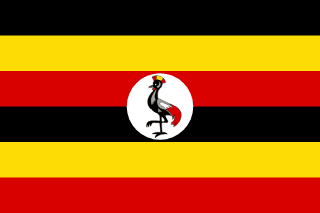Uganda - Geography

Here, let us take a look at the Geography of Uganda. Landlocked; fertile, well-watered country with many lakes and rivers; Lake Victoria, the world's largest tropical lake and the second largest freshwater lake, is shared among three countries: Kenya, Tanzania, and Uganda. Mother's mean age at first birth is 19.4 years (2016 est.) (Note: data represents median age at first birth among women 20-49), whereas, the Maternal mortality ratio is 284 deaths/100,000 live births (2020 est.)
Geographical data of Uganda
| Location | East-Central Africa, west of Kenya, east of the Democratic Republic of the Congo |
|---|---|
| Geographic coordinates | 1 00 N, 32 00 E |
| Map references | Africa |
| Tarrain | mostly plateau with rim of mountains |
| Natural Resources | copper, cobalt, hydropower, limestone, salt, arable land, gold |
| Natural Hazards | droughts; floods; earthquakes; landslides; hailstorms |
| Irrigated Land | 105 sq km (2013) |
| Major rivers (by length in km) | Nile (shared with Rwanda [s], Tanzania, South Sudan, Sudan, and Egypt [m]) - 6,650 km |
| Major aquifers | |
| Land Boundaries | 2,729 km |
| Border Countries | Democratic Republic of the Congo 877 km; Kenya 814 km; Rwanda 172 km; South Sudan 475 km; Tanzania 391 km |
| Coastline | 0 km (landlocked) |
| Climate | tropical; generally rainy with two dry seasons (December to February, June to August); semiarid in northeast |
| Area | |
| Total Area | |
| Land Area | 197,100 sq km |
| Water Area | 43,938 sq km |
| comparative Area | slightly more than two times the size of Pennsylvania; slightly smaller than Oregon |
| Maritime Claims | |
| Elevations | |
| Highest point | Margherita Peak on Mount Stanley 5,110 m |
| Lowest point | Albert Nile 614 m |
| Land Use | |
| Agricultural land | 71.9% (2022 est.) |
| Agricultural land: arable land | arable land: 34.4% (2022 est.) |
| Agricultural land: permanent crops | permanent crops: 11% (2022 est.) |
| Agricultural land: permanent pasture | permanent pasture: 26.5% (2022 est.) |
| Forest | 11.2% (2022 est.) |
| Other | 16.9% (2022 est.) |
Population Distribution
Population density is relatively high in comparison to other African nations; most of the population is concentrated in the central and southern parts of the country, particularly along the shores of Lake Victoria and Lake Albert; the northeast is least populated as shown in this population distribution map
People and Society
In Uganda, the different Ethnic groups are such that we have: Baganda 16.5%, Banyankole 9.6%, Basoga 8.8%, Bakiga 7.1%, Iteso 7%, Langi 6.3%, Bagisu 4.9%, Acholi 4.4%, Lugbara 3.3%, other 32.1% (2014 est.)
| Population | |
|---|---|
| Pop growth rate | 3.18% (2024 est.) |
| Birth rate | 39.6 births/1,000 population (2024 est.) |
| Death rate | 4.7 deaths/1,000 population (2024 est.) |
| Health expenditure | 4.7% of GDP (2021) |
| Physicians Density | |
| Hospital bed Density | 0.5 beds/1,000 population |
| Total fertility rate | 5.17 children born/woman (2024 est.) |
| Gross reproduction rate | 2.55 (2024 est.) |
| Contraceptive prevalence rate | 50.2% (2021) |
| Est married women (ages 15-49) | 58.3% (2023 est.) |
| Literacy | age 15 and over can read and write |
| Education expenditures | 2.7% of GDP (2021 est.) |
| Net Migration rate | -3.1 migrant(s)/1,000 population (2024 est.) |
| Nationality | Ugandan | Ugandan(s) |
| Languages | English (official), Ganda or Luganda (most widely used of the Niger-Congo languages and the language used most often in the capital), other Niger-Congo languages, Nilo-Saharan languages, Swahili (official), Arabic |
| Religions | Protestant 45.1% (Anglican 32.0%, Pentecostal/Born Again/Evangelical 11.1%, Seventh Day Adventist 1.7%, Baptist .3%), Roman Catholic 39.3%, Muslim 13.7%, other 1.6%, none 0.2% (2014 est.) |
| Age Structure | |
| 0-14 years | 47% (male 11,747,745/female 11,427,932) |
| 15-64 years | 50.6% (male 11,788,483/female 13,131,051) |
| 65 years and over | 2.4% (2024 est.) (male 504,332/female 683,498) |
| Dependency Ratios | |
| Total dependency ratio | 88.2 |
| Youth dependency ratio | 85.1 |
| Elderly dependency ratio | 3.2 |
| Potential support ratio | 31.7 (2021 est.) |
| Median Age | |
| Total | 16.2 years (2024 est.) |
| Male | 15.5 years |
| Female | 17.1 years |
| Urbanization | |
| Urban population | 26.8% of total population (2023) |
| Rate of urbanization | 5.41% annual rate of change (2020-25 est.) |
| Major urban areas (Pop) | 3.846 million KAMPALA (capital) (2023). |
| Sex Ratio | |
| At birth | 1.03 male(s)/female |
| 0-14 years | 1.03 male(s)/female |
| 15-64 years | 0.9 male(s)/female |
| 65 years and over | 0.74 male(s)/female |
| Total population | 0.95 male(s)/female (2024 est.) |
| Infant Motality | |
| Total | 28.5 deaths/1,000 live births (2024 est.) |
| Male | 31.8 deaths/1,000 live births |
| Female | 25.1 deaths/1,000 live births |
| Life Expectancy at birth | |
| Total population | 69.7 years (2024 est.) |
| Male | 67.5 years |
| Female | 72 years |
| Drinking Water Sources | |
| Improved: urban | urban: 92.5% of population |
| Improved: rural | rural: 80% of population |
| Improved: total | total: 83.1% of population |
| Unimproved: urban | urban: 7.5% of population |
| Unimproved: rural | rural: 20% of population |
| Unimproved: total | total: 16.9% of population (2020 est.) |
| Sanitation facility acess | |
| Improved: urban | urban: 67.3% of population |
| Improved: rural | rural: 27.5% of population |
| Improved: total | total: 37.4% of population |
| Unimproved: urban | urban: 32.7% of population |
| Unimproved: rural | rural: 72.5% of population |
| Unimproved: total | total: 62.6% of population (2020 est.) |
| Alcohol consumption per capita | |
| Total | 6.82 liters of pure alcohol (2019 est.) |
| Beer | 0.85 liters of pure alcohol (2019 est.) |
| Wine | 0.01 liters of pure alcohol (2019 est.) |
| Spirits | 0.5 liters of pure alcohol (2019 est.) |
| Other alcohols | 5.46 liters of pure alcohol (2019 est.) |
| Tobacco use | |
| Total | 8.4% (2020 est.) |
| Male | 13% (2020 est.) |
| Female | 3.7% (2020 est.) |
| Child marriage | |
| Women married by age 15 | 7.3% |
| Women married by age 18 | 34% |
| Men married by age 18 | 5.5% (2016 est.) |
Demographic profile
All Important Facts about Uganda
Want to know more about Uganda? Check all different factbooks for Uganda below.









